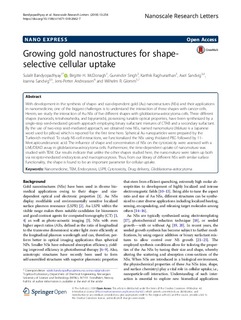| dc.contributor.author | Bandyopadhyay, Sulalit | |
| dc.contributor.author | McDonagh, Birgitte Hjelmeland | |
| dc.contributor.author | Singh, Gurvinder | |
| dc.contributor.author | Raghunathan, Karthik | |
| dc.contributor.author | Sandvig, Axel | |
| dc.contributor.author | Sandvig, Ioanna | |
| dc.contributor.author | Andreassen, Jens-Petter | |
| dc.contributor.author | Glomm, Wilhelm | |
| dc.date.accessioned | 2018-08-30T07:07:04Z | |
| dc.date.available | 2018-08-30T07:07:04Z | |
| dc.date.created | 2018-08-29T14:45:26Z | |
| dc.date.issued | 2018 | |
| dc.identifier.issn | 1931-7573 | |
| dc.identifier.uri | http://hdl.handle.net/11250/2559948 | |
| dc.description.abstract | With development in the synthesis of shape- and size-dependent gold (Au) nanostructures (NSs) and their applications in nanomedicine, one of the biggest challenges is to understand the interaction of these shapes with cancer cells. Herein, we study the interaction of Au NSs of five different shapes with glioblastoma-astrocytoma cells. Three different shapes (nanorods, tetrahexahedra, and bipyramids), possessing tunable optical properties, have been synthesized by a single-step seed-mediated growth approach employing binary surfactant mixtures of CTAB and a secondary surfactant. By the use of two-step seed-mediated approach, we obtained new NSs, named nanomakura (Makura is a Japanese word used for pillow) which is reported for the first time here. Spherical Au nanoparticles were prepared by the Turkevich method. To study NS-cell interactions, we functionalized the NSs using thiolated PEG followed by 11-Mercaptoundecanoic acid. The influence of shape and concentration of NSs on the cytotoxicity were assessed with a LIVE/DEAD assay in glioblastoma-astrocytoma cells. Furthermore, the time-dependent uptake of nanomakura was studied with TEM. Our results indicate that unlike the other shapes studied here, the nanomakura were taken up both via receptor-mediated endocytosis and macropinocytosis. Thus, from our library of different NSs with similar surface functionality, the shape is found to be an important parameter for cellular uptake. | nb_NO |
| dc.language.iso | eng | nb_NO |
| dc.publisher | SpringerOpen | nb_NO |
| dc.rights | Navngivelse 4.0 Internasjonal | * |
| dc.rights.uri | http://creativecommons.org/licenses/by/4.0/deed.no | * |
| dc.title | Growing gold nanostructures for shape-selective cellular uptake | nb_NO |
| dc.type | Journal article | nb_NO |
| dc.type | Peer reviewed | nb_NO |
| dc.description.version | publishedVersion | nb_NO |
| dc.source.volume | 13 | nb_NO |
| dc.source.journal | Nanoscale Research Letters | nb_NO |
| dc.source.issue | 254 | nb_NO |
| dc.identifier.doi | https://doi.org/10.1186/s11671-018-2662-7 | |
| dc.identifier.cristin | 1605333 | |
| dc.description.localcode | © The Author(s). 2018 Open Access This article is distributed under the terms of the Creative Commons Attribution 4.0 International License (http://creativecommons.org/licenses/by/4.0/) | nb_NO |
| cristin.unitcode | 194,66,30,0 | |
| cristin.unitcode | 194,66,50,0 | |
| cristin.unitcode | 194,66,35,0 | |
| cristin.unitcode | 194,65,30,0 | |
| cristin.unitcode | 194,65,60,0 | |
| cristin.unitname | Institutt for kjemisk prosessteknologi | |
| cristin.unitname | Felles forskningsinfrastruktur | |
| cristin.unitname | Institutt for materialteknologi | |
| cristin.unitname | Institutt for nevromedisin og bevegelsesvitenskap | |
| cristin.unitname | Kavliinstitutt for nevrovitenskap | |
| cristin.ispublished | true | |
| cristin.fulltext | postprint | |
| cristin.qualitycode | 1 | |

